Maintaining your vehicle is crucial for safety and longevity, and while some aspects might seem minor, windshield wipers are undeniably essential. At cardiagnosticnearme.com, we emphasize preventative maintenance, and regularly replacing your wiper blades is a key part of that. To simplify your choice, our expert auto repair team has rigorously tested and evaluated the best wiper blades available on the market. Whether you’re facing torrential downpours or light drizzle, having the Best Rated Wiper Blades ensures optimal visibility and driving safety.
We’ve experienced firsthand the critical difference quality wipers make in challenging weather conditions. A top-tier set, like our overall pick, the Rain-X Silicone Endura, provides superior silicone performance for extended durability. However, for those in drier climates, the AERO Voyager J-Hook wipers offer a budget-friendly yet high-quality beam design.
While wiper blades may not be the most glamorous car accessory, their performance is critical for safety. There are significant differences between subpar and exceptional wiper blades. Our comprehensive guide breaks down the nuances, from traditional to beam styles and rubber to silicone materials, to help you choose the best. Based on extensive testing in diverse conditions, particularly in the demanding Pacific Northwest, we present our top recommendations for 2025.
Editor’s Note: Our guide to the best windshield wipers was updated on March 19, 2025, to include the AERO Voyager J-Hook as our best budget pick and the Anco Winter Wiper as a top choice for winter driving.
Best Overall Windshield Wipers: Rain-X Silicone Endura
Rain-X Silicone Endura
Rating: 9.1 / 10
See our product rating methodology ⓘ
Key Features:
- Wiper Style: Beam
- Blade Material: Silicone
- Available Lengths: 14-28 inches
- Attachment Types: J-hook, pinch tab, pinch tab button, pin arm, side pin
Pros:
- Premium silicone blade with graphite coating for extended lifespan compared to rubber.
- Elevated pivot point enhances clamping force against the windshield.
- Silicone blade applies a water-repellent treatment with each use.
- Secure locking clasp mechanism.
Cons:
- Pricier than standard wiper blades.
- Less readily available compared to Rain-X’s Advantedge Premium wipers.
The Rain-X Silicone Endura ($26) stands out as a top contender among windshield wipers today. It effectively combines a robust beam design, a high-performance silicone blade, and a built-in water repellent feature, resulting in long-lasting performance that impressed us during our rigorous testing. For car owners seeking the best rated wiper blades for overall performance, the Silicone Endura is an excellent choice.
Silicone wiper blades offer significant advantages over traditional natural rubber blades. They resist degradation from UV exposure, ozone, and extreme temperature fluctuations, ensuring a longer service life. Furthermore, as they operate, these blades gradually deposit silicone, creating a Rain-X-like water-repellent layer on your windshield, causing water to bead and roll off effectively. This dual action of wiping and water-repellency enhances visibility significantly in wet conditions.
In our comparative tests, the Silicone Endura blades exhibited minimal streaking and operated remarkably quietly, even at high wiper speeds. Consistent with many silicone blades, their performance seems to improve over time as the silicone film builds up on the windshield. Priming the blades by running them dry for a few cycles can help establish this silicone layer and optimize water beading from the start.
The mounting attachments of the Silicone Endura blades are robust and designed to raise the pivot point slightly higher than many other wipers we tested. This design increases the clamping force exerted on the windshield, ensuring consistent contact and effective wiping. While the J-hook attachment release might require a bit of practice (tilting the blade perpendicular before depressing the tab), once mastered, it’s straightforward. The inclusion of a locking clasp provides an additional layer of security, preventing the blades from detaching unexpectedly.
When directly compared to our premium pick, the PIAA Si-Techs, we observed virtually no discernible differences. Even the serial numbers were identical, leading us to believe these wipers are essentially the same product. This similarity is a significant advantage for the Enduras, especially considering they are often available for around $10 less per blade. For most drivers looking for the best rated wiper blades that offer premium performance without the premium price tag, the Rain-X Silicone Endura is the ideal choice.
Best Budget Windshield Wipers: AERO Voyager J-Hook
AERO Voyager J-Hook
Check Price at Walmart$17 at Amazon
Rating: 6.1 / 10
See our product rating methodology ⓘ
Key Features:
- Wiper Style: Beam
- Blade Material: Rubber
- Available Lengths: 13-28 inches
- Attachment Types: Small and large J-hook
Pros:
- Very affordable, especially as a set of two wipers.
- DuPont Teflon coating for smoother operation.
- 1-year warranty for peace of mind.
- Includes an extra set of rubber wiper elements for extended value.
- Aerodynamic wiper design with an integrated wiper arm cover.
Cons:
- Exclusively available in J-hook attachment style.
- Rubber blades are not as efficient at clearing water as silicone and may squeak when dry.
Previously, we often suggested traditional branch-style wipers as the go-to budget option. However, after testing the AERO Voyager J-Hook Wiper Blades ($17), we’ve revised our recommendation. These modern beam wipers offer superior design and performance, yet are surprisingly affordable, often costing half the price of our previous budget pick. For drivers seeking the best rated wiper blades on a budget, the AERO Voyager J-Hook blades offer exceptional value.
At just $17 for a pair, the AERO Voyager wipers are incredibly economical. Considering this price point, purchasing two sets and storing one as a spare is a practical option. Adding to their value, they include a bonus set of replacement rubber wiper elements and a 1-year warranty. AERO deserves credit for incorporating replaceable squeegees, making these wipers more environmentally friendly than many competitors that require complete replacement.
During both stationary and on-road testing, the rubber wiper elements of the Voyager blades didn’t clear water as effectively as silicone blades. However, the Teflon treatment significantly reduces the squeaking commonly associated with untreated rubber wipers. This coating helps ensure smoother, quieter operation, which is a notable advantage in budget wiper category.
The 1-year warranty distinguishes these wipers from most others, even outperforming our top pick’s 90-day warranty. This extended warranty provides added value and reassurance should any unexpected issues arise. Our long-term testing over six months has shown no problems with their performance or durability.
The primary trade-off for the budget price is in mounting versatility. The Voyager blades are only compatible with J-hook wiper arms. If your vehicle uses a different attachment style and you need budget-friendly wipers, the Trico Flex blades are a comparable alternative. However, for vehicles with J-hook arms, the AERO Voyager blades represent the best deal available, offering excellent performance and features for their price.
Best Branch-Style Windshield Wipers: SilBlade Standard
SilBlade Standard
Rating: 6.8 / 10
See our product rating methodology ⓘ
Key Features:
- Wiper Style: Branch
- Blade Material: Silicone
- Available Lengths: 11-28 inches
- Attachment Types: J-hook, pin arm
Pros:
- Silicone wipers at a budget-friendly price point.
- Wide range of available lengths to fit various vehicles.
- Durable powder-coated steel construction, more robust than typical branch wipers.
Cons:
- Mounting hardware is less secure and offers limited attachment options.
- Branch-style design is less effective in snowy conditions compared to beam styles.
Choosing branch-style windshield wipers usually means settling for cheaper rubber blades. However, the SilBlade Standard ($26) defies this expectation. These wipers are ideal for drivers in drier climates who may not require the advanced performance of beam-style wipers but still desire the benefits of silicone blades. They offer an economical solution that prioritizes quality where it matters most. For those specifically seeking the best rated wiper blades in a branch style, the SilBlade Standard is a compelling option.
In our performance testing, the SilBlade Standards ranked in the middle, providing adequate wiping with minimal streaking and noise. We did observe some slight shuddering at the end of the wiper stroke, noticeable in slow-motion footage but not significantly distracting during everyday driving. For typical daily use, their performance is more than satisfactory.
Available in a broad spectrum of lengths (11-28 inches), SilBlade Standards are compatible with a wide range of vehicles. However, attachment options are limited to the most common J-hook and pin arm types. While we easily installed them on our test truck, owners of some European vehicles might encounter compatibility issues.
For those seeking a more modern design, SilBlade also offers beam-style FlexBlade wipers and hybrid UniBlade options. The silicone SilBlade Standards are a sensible choice for drivers who want to avoid both premium-priced and bargain-bin wipers, offering a balance of silicone performance and branch-style affordability. They represent a solid middle ground for drivers prioritizing value and silicone blade benefits in a traditional frame.
Best Beam-Style Windshield Wipers: Bosch Icon
Bosch Icon
$26 at AmazonCheck price at Tire Rack
Rating: 8.9 / 10
See our product rating methodology ⓘ
Key Features:
- Wiper Style: Beam
- Blade Material: Rubber
- Available Lengths: 13-28 inches
- Attachment Types: J-hook, side-lock, pinch-tab, top-lock
Pros:
- High-quality beam design with exceptional flexibility.
- Easiest wiper to install among those tested, featuring a locking clasp.
- Excellent choice for cold weather driving where silicone blades might be prone to tearing.
Cons:
- Traditional rubber blades are not as versatile as silicone across all weather conditions.
- Fewer attachment types compared to some competitors.
The Bosch Icon ($30) wiper blades have earned their widespread popularity, and our testing confirms their well-deserved reputation. These beam-style wipers represent the pinnacle of beam design, featuring a smooth flex pattern and an aggressive curvature that ensures consistent contact with your windshield. For drivers prioritizing beam-style wipers, the Bosch Icon stands out as one of the best rated wiper blades available.
While we generally favor silicone blades for their superior performance, the rubber compound used in the Bosch Icons is undeniably effective. Our tests demonstrated that these wipers clear water exceptionally well, even outperforming the Rain-X Latitudes in streak reduction. While long-term durability might be a slight compromise compared to silicone, this is not due to build quality but rather inherent rubber limitations.
Installation of the Bosch Icons was the easiest among all wipers we tested for this guide. The simple locking clasp securely fastens the blade with a single motion. Removing these wipers was also remarkably user-friendly, a welcome contrast to many other wipers that often pinched fingers with their release tabs. The ease of installation and removal is a significant user experience advantage.
In very cold and icy conditions, silicone wiper blades can become somewhat brittle and may tear if forced across ice buildup on an unscraped windshield. If you frequently drive in such environments, opting for robust rubber wipers like the Bosch Icons is a prudent choice. Their durability in freezing conditions makes them a reliable option for winter driving.
Best Premium Windshield Wipers: PIAA Si-Tech
PIAA Si-Tech
$36 at AmazonCheck price at Tire Rack
Rating: 9.2 / 10
See our product rating methodology ⓘ
Key Features:
- Wiper Style: Beam
- Blade Material: Silicone
- Available Lengths: 14-28 inches
- Attachment Types: J-hook, push-button arm, side-pin, bayonet, pin & hook
Pros:
- High-performance beam design and silicone wiper blades.
- Includes windshield prep wipes to enhance silicone water-repellent treatment.
- PIAA offers wiper refills, extending the life of the wipers.
- 1-year limited warranty for added assurance.
Cons:
- Lacks a locking clasp feature.
- More expensive than most other wiper blades.
As previously mentioned, the PIAA Si-Tech ($36) windshield wipers are, to the best of our assessment, nearly identical to the Rain-X Silicone Enduras, with a few minor distinctions. Whether these differences justify the price increase is subjective, but they do position the Si-Techs as our top pick for premium wipers. For drivers seeking the absolute best rated wiper blades with premium features, the PIAA Si-Tech is an unmatched choice.
One key differentiator is that the Si-Tech wipers include a windshield preparation pack containing an alcohol cleaner and liquid silicone. This pre-treatment enhances the silicone wiper benefits, and our testing showed a superior water-repellent coating compared to using silicone wipers alone. While a similar effect can be achieved with aftermarket products like Rain-X treatment, the inclusion of prep wipes elevates the Si-Tech package.
Furthermore, PIAA offers silicone wiper refills for the Si-Tech model, a feature not available for Rain-X wipers. This refill option allows users to easily maintain wiper performance and extend the life of their initial purchase by replacing only the worn squeegee elements.
The beam design of the PIAA Si-Tech wipers performed on par with the best from Rain-X and Bosch in our water-clearing tests. The full blade contact and minimal streaking, combined with low operational noise, were notable. Even as the initial wipe-on treatment fades, the silicone blades continue to deposit a water-repellent layer, sustaining water beading over time.
While they come at a higher cost, the added features, particularly the windshield prep and refill availability, make the Si-Tech wipers the top choice for drivers seeking turn-key premium performance and long-term value.
Best Winter Windshield Wipers: Anco Winter Wiper
Anco Winter Wiper
Rating: 7.0 / 10
See our product rating methodology ⓘ
Key Features:
- Wiper Style: Branch
- Blade Material: Rubber
- Available Lengths: 11-24 inches
- Attachment Types: J-hook, side pin, small and large bayonet styles
Pros:
- Rubber cover fully encloses the wiper for protection against ice and snow.
- Rubber wiper elements are less prone to tearing in very low temperatures.
- Affordable price point for seasonal use.
Cons:
- Wiping performance is not as effective as other top-rated wipers in standard conditions.
- Wiper arm mount is not the most robust design.
Winter conditions can severely impact wiper blade performance. While silicone beam wipers like the Bosch Icons perform admirably, they can also suffer damage in harsh winter weather. Just as you switch to snow tires, we recommend swapping to winter-specific wiper blades. The Anco Winter Wiper Blades ($25) are our top recommendation for winter driving. For drivers in regions with harsh winters, the Anco Winter Wiper is among the best rated wiper blades designed for snow and ice.
These wipers are intentionally basic, designed for sacrificial use during harsh winter months. Their key winter feature is a thick rubber sleeve encasing the entire blade, preventing snow and ice buildup that can hinder performance. After a season of driving in snowy conditions in the North Cascades, their effectiveness was clearly demonstrated.
The wiper blades are made of rubber, which, while not ideal for peak water clearing in normal conditions, is more resilient to tearing when dragged across icy windshields compared to silicone. We found their performance adequate for Pacific Northwest winters, especially when combined with a Rain-X treatment to enhance water repellency. Since the wipers themselves are not pre-treated, windshield treatments are beneficial for optimal performance throughout the season.
The connection mechanism is straightforward and compatible with hook, side-pin, and small/large bayonet wiper arms. We easily installed them on our Honda CRV test vehicle at the onset of winter and swapped them back to our standard wipers in spring.
An added benefit of seasonal wiper swaps is extending the lifespan of your summer blades. The Anco Winter blades are our recommended choice for a reliable and affordable set of winter wipers, ensuring safety and visibility during the coldest months.
Other Windshield Wipers We Considered
The wipers highlighted above are our primary recommendations, based on extensive testing and long-term use on our own vehicles. They have proven reliable even in severe weather. However, numerous other excellent options are available. Consider these alternatives before making your final purchase:
Trico Silicone Ceramic
$27 at AmazonCheck price at Tire Rack
Rating: 7.1 / 10
See our product rating methodology ⓘ
Key Features:
- Wiper Style: Beam
- Blade Material: Silicone
- Available Lengths: 14-28 inches
- Attachment Types: J-hook, push button, side-pin, pinch-tab
Pros:
- Highly aerodynamic design.
- Silicone wiper elements with ceramic coating to minimize friction.
- Excellent contact across the entire wiping surface.
Cons:
- Among the more expensive wiper blade options.
- Broad attachment base may restrict flexibility across the entire wiper.
The Trico Silicone Ceramic ($36) is a premium-priced wiper blade, but it justifies the cost with advanced features. The higher price reflects the sophisticated chemistry incorporated into these blades, particularly the ceramic coating designed to ensure smooth and consistent operation.
Wiping performance is comparable to the PIAA Si-Tech and Rain-X Silicone Endura wipers. The ceramic coating is intended to extend the lifespan of these blades by reducing friction and wear over time. A primary cause of wiper blade shudder and noise is windshield debris, and the ceramic coating aids in gliding smoothly over contaminants, prolonging blade life.
This wiper blade features a notably aerodynamic design, incorporating an integrated spoiler that helps maintain consistent windshield contact. While we are skeptical of any significant downforce generation, the contact across the blade is excellent, with no observed shuddering even at high speeds.
Choosing between the Trico Silicone Ceramic and PIAA Si-Tech is a difficult decision. We slightly favor the PIAA due to its more aggressive curvature and included water-repellent wipes. However, in terms of long-term performance and durability, the Silicone Ceramics are a strong contender.
Rain-X Latitude Water Repellency
Rating: 7.3 / 10
See our product rating methodology ⓘ
Key Features:
- Wiper Style: Beam
- Blade Material: Rubber
- Available Lengths: 14-28 inches
- Attachment Types: J-hooks, pinch-tab, pin-arms, pinch-tab button
Pros:
- Silicone Rain-X coating ensures smooth operation of rubber blades.
- Well-curved beam design for consistent contact.
- Quiet operation, even at high speeds.
Cons:
- Bulkier attachment mount.
- Rain-X treatment is not permanent and can feel greasy when handled.
The Rain-X Latitude Water Repellency ($18) wipers occupy a solid mid-range position in our rankings. They offer effective water removal, a durable beam design, and a Rain-X coating that promotes smooth, consistent wiping. For a rubber wiper blade, they perform exceptionally well.
As rubber blades, the Latitude wipers incorporate a 2-in-1 design with a silicone treatment applied to the blades. This treatment is transferred to the windshield during initial use. While not as long-lasting as dedicated wipe-on treatments or silicone blades, it effectively beads water after just a few wipes in our tests. We observed this treatment lasting for a full summer and fall of regular use in the Pacific Northwest.
The beam design closely resembles the Rain-X Silicone Endura but features a slightly more aggressive curve, enhancing windshield contact at higher speeds. The attachment mount is somewhat bulky, which may slightly increase wind resistance compared to sleeker designs.
Frequently available for around $18 per blade, the Latitude Water Repellency wipers are an excellent budget-conscious option. Combining them with Rain-X Washer Fluid Additive can further extend the water-beading performance throughout the year, potentially negating the need for full silicone wipers for some drivers.
Trico Flex
Rating: 6.9 / 10
See our product rating methodology ⓘ
Key Features:
- Wiper Style: Beam
- Blade Material: Rubber
- Available Lengths: 13-32 inches
- Attachment Types: J-hook, pinch-tab, side-pin, push-button, side-lock, bayonet
Pros:
- Very budget-friendly pricing.
- Solid beam design for consistent pressure.
- Wide range of available lengths.
Cons:
- Minor streaking observed during testing.
- Plastic frame feels less durable and has a less pronounced curve.
A close competitor for our best budget pick, the Trico Flex ($17) wiper blades offer significant value at a low cost. While they utilize a more economical rubber wiper insert, the beam blade design is effective, providing excellent water removal with only slight streaking in our tests.
The Trico Flex wipers compare favorably to the Bosch Icons, with the primary advantage of the Icons being their superior attachment mechanism. Despite this, the Trico Flex performance is commendable for its price point.
In hand, the Trico Flex blades feel slightly less premium in build quality compared to higher-priced competitors. The plastic frame and mount might not inspire the same confidence as more robust designs. Attachment compatibility is also somewhat limited, which may require those with less common wiper arm types to explore other options.
As an excellent budget choice, the Flex wiper blades offer dependable performance across various tests. If you don’t require top-tier performance or live in a region with minimal rainfall, these wipers offer a cost-effective solution that will adequately handle typical driving conditions.
Tested and proven, we went through some serious washer fluid testing these wipers; (photo/Erika Courtney)
Windshield Wiper Comparison Chart
| Windshield Wipers | Price (Per Wiper) | Wiper Style | Blade Material | Available Lengths |
|---|---|---|---|---|
| Rain-X Silicone Endura | $26 | Beam | Silicone | 14-28” |
| AERO Voyager J-Hook | $8 | Beam | Rubber | 13-28” |
| SilBlade Standard | $26 | Branch | Silicone | 11-28” |
| Bosch Icon | $30 | Beam | Rubber | 13-28” |
| PIAA Si-Tech | $36 | Beam | Silicone | 14-28” |
| Anco Winter Wiper | $25 | Branch | Rubber | 11-24” |
| Trico Silicone Ceramic | $36 | Beam | Silicone | 14-28” |
| Rain-X Latitude Water Repellency | $18 | Beam | Rubber | 14-28” |
| Trico Flex | $17 | Beam | Rubber | 13-32” |
How We Tested the Best Windshield Wipers
After countless wiper blade swaps, we gained fingertips of steel — and a pretty good understanding of what makes a good set; (photo/Nick Belcaster)
It would be easy to simply recommend any generic wiper blade, but our goal was to conduct thorough testing to differentiate truly exceptional wipers from merely adequate ones. We aimed to delve into the details and provide data-driven recommendations. Our process involved extensive research, both online and through consultations with our team of experienced automotive experts, to understand real-world performance and user preferences. Our selection aims to address a wide range of needs and vehicle types, ensuring there is a suitable option for every driver.
Our Testing Process and Testing Grounds
We adopted a scientific approach to wiper blade testing, focusing on objective data to minimize marketing influence and ensure reliable, repeatable results. Our testing setup included a Toyota Tacoma, precision sprinklers, a slow-motion camera, and an audio recorder. This controlled environment allowed us to systematically evaluate each wiper’s performance.
Each wiper blade was tested under identical conditions, with consistent water volume and wiper speed. Performance metrics were recorded and analyzed to determine water removal efficiency and noise levels. For blades requiring silicone wipe-on treatments, we meticulously cleaned the windshield between tests to ensure a sterile surface and accurate results.
Installation and removal processes were also carefully evaluated. We challenged multiple testers to install each wiper set without referring to instructions, observing ease of use and potential difficulties. This hands-on assessment provided valuable insights into the user-friendliness of each wiper’s mounting system.
Beyond controlled lab conditions, we conducted extensive real-world road testing. This involved driving through heavy rain on the Olympic Peninsula, snowstorms in British Columbia, and muddy conditions en route to remote campsites. Frequent blade changes during these trips provided ample experience with different wiper models, highlighting ease of installation and on-road performance in diverse weather.
Finally, we continuously monitor the durability and longevity of these wiper blades through ongoing use on our vehicles, tracking performance until failure. Our reviews are regularly updated to reflect this long-term data, and we incorporate new wiper models as they become available, ensuring our recommendations remain current and comprehensive.
Our Expert Testers
Leading our wiper blade testing is Nick Belcaster, based just north of Seattle, a region renowned for its frequent rainfall. His extensive experience with heavy precipitation necessitates annual wiper blade replacements and even occasional wiper motor replacements due to overuse. His travels across the West have exposed him to diverse and challenging weather conditions, making him acutely aware of the critical role of reliable wiper blades.
Our wiper evaluations are further enhanced by a team of GearJunkie editors and contributors with deep automotive knowledge. They provide testing feedback from their personal vehicles, adding a broad spectrum of real-world usage data to our reviews. This collective expertise ensures our recommendations are well-rounded and reflect a wide range of driving experiences.
Buyer’s Guide: How to Choose Windshield Wipers
The first rule of windshield wipers — replace them before you need them; (photo/Erika Courtney)
While often an afterthought during routine car maintenance, wiper blades are crucial for driving safety. While makeshift solutions exist in emergencies, preemptive replacement is always best. Just like ensuring clear headlights, maintaining proper tire inflation, and addressing engine codes promptly, regular wiper maintenance is essential for vehicle safety and longevity. Choosing the best rated wiper blades is a key part of this maintenance.
Our testing has revealed that even seemingly simple wiper blades incorporate significant technology. Design, blade material, and coatings all impact performance and durability. Consider these factors when choosing your next set to ensure you get the best value and performance for your money.
Windshield Wiper Blade Design
Branch-style wipers are old and trusty, while beam-style blades provide a better wiper overall; (photo/Erika Courtney)
Windshield wiper blade technology has evolved, enhancing performance through design innovations. Two primary frame designs exist: traditional branch frames and modern beam frames.
Traditional Branch Frames
Branch frames are the classic wiper design used for decades. While simple and adaptable to windshield curvature, they apply less force to maintain consistent glass contact. Typically made of painted or powder-coated steel, these frames are susceptible to wear and rust over time, especially under heavy use.
In snowy or icy conditions, branch-style wipers can accumulate ice buildup between the frame elements, causing chattering and reduced wiping efficiency. However, for drivers in drier climates, branch wipers like the SilBlade Standards or PIAA Super Silicones offer an economical option. We typically use branch-style wipers for rear windows where performance demands are less critical.
Beam Frames
The curvature of beam blades ensures they make even contact across the entire windshield; (photo/Erika Courtney)
Modern vehicles commonly use beam frame wipers. These feature a one or two-piece design with integrated metal bands that distribute pressure evenly across the wiper blade. Lacking pressure points, beam wipers typically outperform branch styles, offering smoother, quieter operation with fewer skips and hang-ups.
Beam-style wipers maintain tighter windshield contact, enhancing aerodynamics and reducing wind noise and lift. In our tests, the Bosch Icons exemplify perfected beam design, providing excellent flexibility and consistent contact across the windshield.
Hybrid Frames
Hybrid frames blend branch and beam designs, incorporating an aerodynamic cover over a branch frame. This reduces wind lift and icing issues common with traditional branch frames, combining some advantages of both styles.
Performance
Watching water move off your windshield isn’t the most action-packed way to spend a weekend, but it bore out some good data; (video/Nick Belcaster)
Quantifying wiper performance requires detailed testing. We developed a quasi-scientific test to differentiate wiper quality. Using a garden hose and ladder, we simulated various rainfall intensities, from light sprinkles to heavy downpours, mimicking typical Pacific Northwest weather conditions. We recorded our observations for detailed analysis.
The primary wipe stroke, which clears the majority of water, was our focus. We assessed smoothness, streak-free operation, and noise levels, recording audio for comparison. Less effective blades often exhibited hang-ups and streaking, particularly at the blade ends.
During pauses between wipes, we evaluated water removal efficiency by observing windshield clarity before the next water spray. Beam-style wipers consistently provided superior windshield contact and more uniform water removal compared to branch frames.
Silicone wipers also demonstrated a clear performance advantage. After just a few wipes, silicone transfer to the glass began, enhancing water beading and allowing for effective clearing at lower wiper speeds.
Wiper Compounds
The material used in your wiper element can make a big difference in water clearing and longevity; (photo/Nick Belcaster)
The wiper blade or squeegee element is critical for performance. These thin strips of rubber or silicone are shaped to conform to the windshield, effectively squeegeeing water away.
Rubber Blades
Natural rubber has been the standard wiper blade material for many years, providing effective wiping when well-maintained. However, dirty windshields are a primary cause of rubber blade degradation, leading to reduced performance and damage.
Rubber blades have a limited lifespan due to environmental factors. UV radiation, atmospheric ozone, and temperature extremes degrade rubber over time, necessitating periodic replacement.
Silicone Blades
Silicone wipers, although typically more expensive, offer several advantages over rubber. They exhibit superior resistance to environmental degradation, including UV, ozone, and temperature fluctuations. Silicone blades also deposit a thin silicone film on the windshield with each wipe, enhancing water repellency.
Wipers like the Rain-X Silicone Endura and PIAA Si-Tech consistently outperformed rubber blades in our tests. Their performance often improves with use as the silicone layer builds on the windshield, further enhancing water beading and visibility.
Coated Blades
Both rubber and silicone blades are often treated with coatings like Teflon or graphite to reduce friction and improve performance. These coatings, while not permanent, enhance wiping efficiency and reduce wear, extending blade lifespan.
The graphite coating on Rain-X Latitudes contributes to their quiet operation, while the ceramic coating on Trico Silicone Ceramics provides advanced friction reduction for smoother wiping.
For some reason, auto manufacturers haven’t settled on a universal wiper attachment by now, leaving us with plenty of different mounts to sift through; (photo/Erika Courtney)
Wiper Blade Mounting
While J-hook is the most common wiper arm attachment, vehicles use various mounting styles, including side pins, bayonets, and push-button mounts.
Wiper blades often incorporate multiple adapters to ensure broad vehicle compatibility. Given the complexity of wiper attachments, consulting an auto parts store or online resource to verify compatibility with your specific vehicle is advisable.
“Exact fit” wiper blades designed to meet original equipment (OE) specifications are also available. These blades are tailored for specific vehicle models, simplifying installation by eliminating adapters.
While there are many different mounting attachments out there, the J-hook is a fairly common one; (photo/Erika Courtney)
Durability and When to Replace
Even the best rated wiper blades require eventual replacement. Investing in durable, high-quality blades can extend replacement intervals. Regular wiper blade checks are part of essential vehicle maintenance to prevent performance degradation.
Most wiper blades begin to show performance decline around six months, with annual replacement being common. However, premium silicone blades can last up to two years with minimal performance loss.
Beam-style designs generally offer greater durability due to fewer moving parts and reduced debris or ice accumulation. Silicone blades also outlast rubber due to their superior material stability.
Using water-repellent treatments like Rain-X can significantly enhance wiper performance by promoting water beading and runoff, reducing wiper usage in light rain. Regular wiper blade cleaning also prolongs their lifespan by removing debris that can cause damage.
Replace wiper blades when streaking, chattering, or squeaking becomes noticeable. These are clear indicators of reduced performance and compromised visibility.
Better to replace your wipers before you really end up needing them; (photo/Erika Courtney)
Price & Value
Windshield wipers are relatively inexpensive but vary in price and quality. Your local climate and driving conditions should influence your spending. Drivers in rainy or snowy regions will benefit more from higher-quality, more expensive wipers than those in drier areas.
Budget
For dry climates or fair-weather vehicles, budget wipers can suffice. These are typically rubber branch-style blades, offering adequate performance at a low cost. The AERO Voyager J-Hook ($17) offers a slight upgrade with a beam design at a budget price.
Mid-Tier
Spending $20-$30 per wiper accesses mid-range options like the $26 Rain-X Silicone Endura, which provides enhanced silicone blade performance. Beam-style wipers become more common in this range, offering improved windshield contact. The Bosch Icon ($30) is a top performer in this category.
Premium
Spending over $30 per wiper (over $60 per set) is a premium investment, worthwhile for drivers in extreme conditions where optimal visibility is paramount. These wipers, like the PIAA Si-Tech ($36), are typically silicone beam blades, offering top-tier performance and durability.
Frequently Asked Questions
What are the best-rated windshield wipers?
For overall performance, we recommend the Rain-X Silicone Endura. Their silicone blades provide excellent water clearing and continuously apply a water-repellent coating for lasting visibility.
For a slightly higher price, the PIAA Si-Tech wipers are comparable but include a wipe-on water-repellent treatment for enhanced initial performance.
Do expensive windshield wipers make a difference?
Extremely expensive wipers may not offer significantly better performance, but very cheap wipers will likely underperform. Mid-range wipers like the Bosch Icon or Rain-X Latitude offer a good balance of performance and value.
More expensive wipers often feature beam designs and silicone squeegees, both contributing to improved performance and longevity.
Which wipers last the longest?
Silicone wiper blades significantly outlast rubber blades due to their resistance to UV, ozone, and temperature damage. Beam designs also tend to be more durable than branch styles.
The PIAA Si-Tech wipers are a top choice for longevity, combining high-quality materials with available wiper refills to extend their lifespan.
What is the average life of a wiper?
Average wiper lifespan is about one year with regular use, potentially longer with frequent windshield cleaning. High-end silicone wipers can last even longer due to their material durability.
Streaking or noisy operation indicates it’s time to consider wiper blade replacement.
Are silicone wiper blades better than rubber?
For optimal all-weather performance, silicone wipers are generally superior, providing smoother wiping and longer lifespan compared to rubber.
However, in extremely cold and icy climates, rubber wipers may be preferable as silicone can become brittle and tear when used on iced windshields.
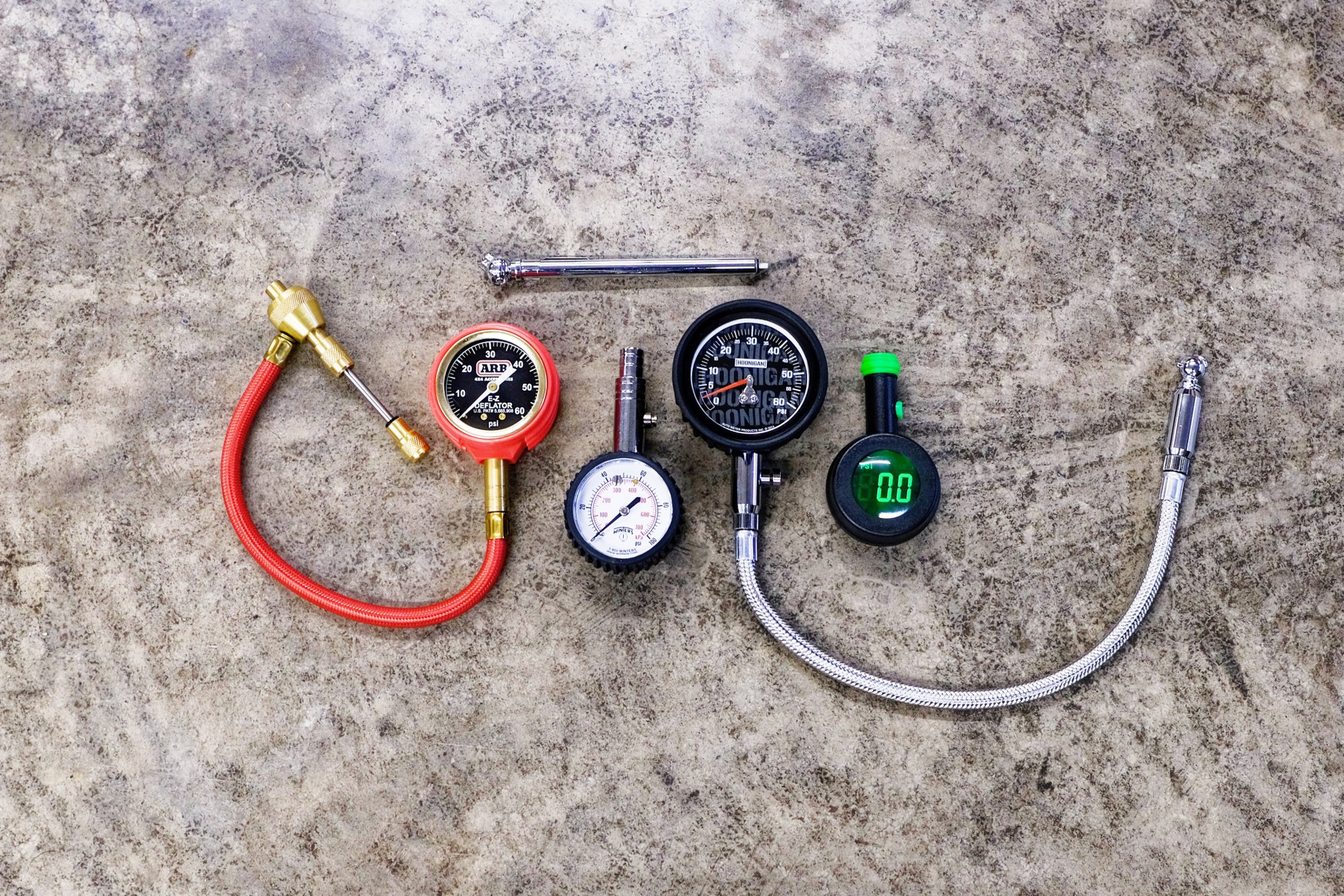 Motors
Motors
The Best Tire Pressure Gauges of 2024
Keeping your tires properly pressured is a key part of automotive maintenance. These user-friendly tire pressure gauges will help you dial them in.
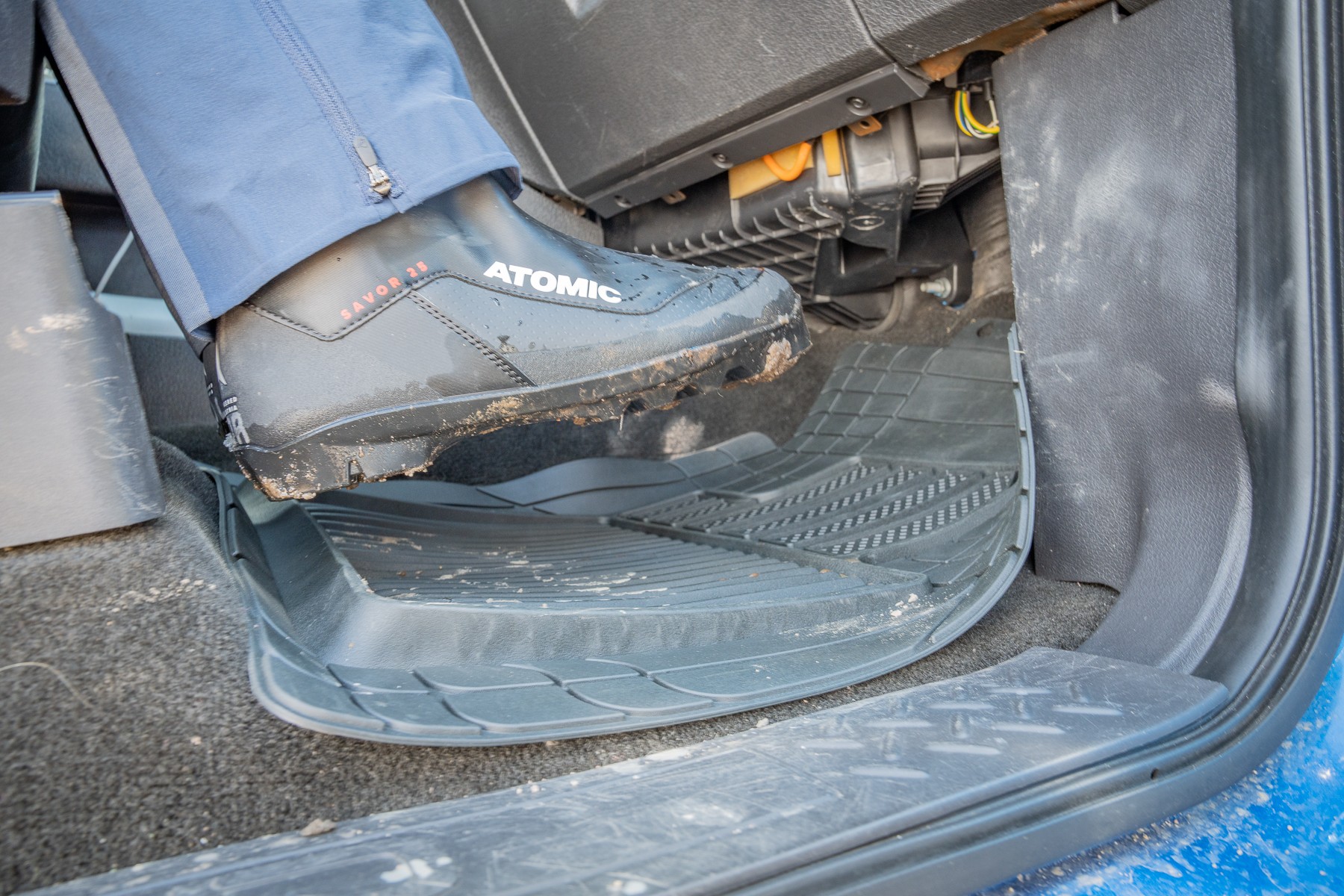 Motors
Motors
The Best Car Floor Mats of 2025
We don’t shy away from gunk in the outdoors, so our GearJunkie crew tested the best floor mats for cars and trucks to help keep our rides fresh. Check out our picks from WeatherTech, Husky Liners, and more.
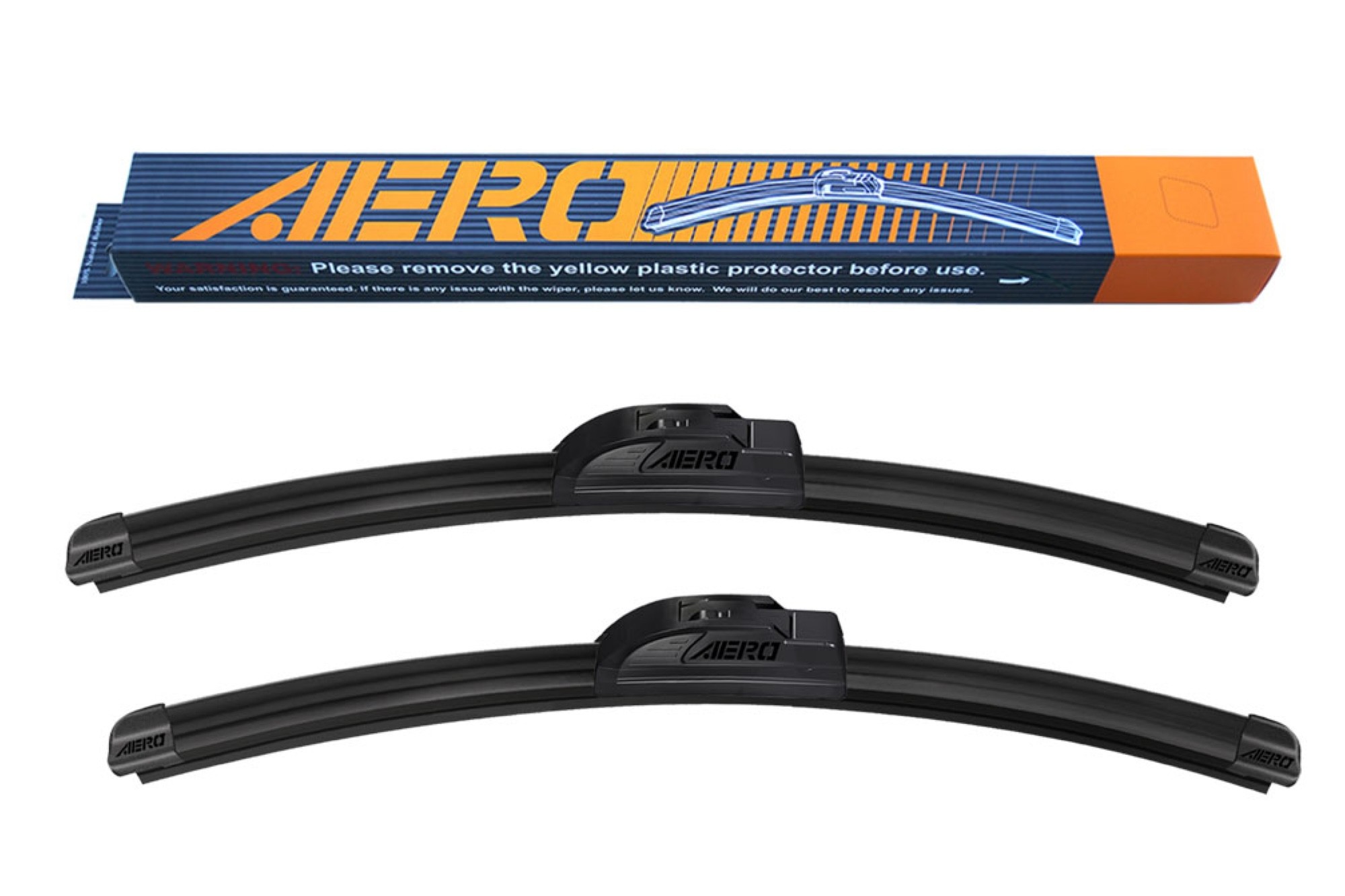 AERO Voyager J-Hook wiper blades displayed to highlight their beam style and rubber blade, emphasizing their value as best rated wiper blades for budget-conscious buyers.
AERO Voyager J-Hook wiper blades displayed to highlight their beam style and rubber blade, emphasizing their value as best rated wiper blades for budget-conscious buyers.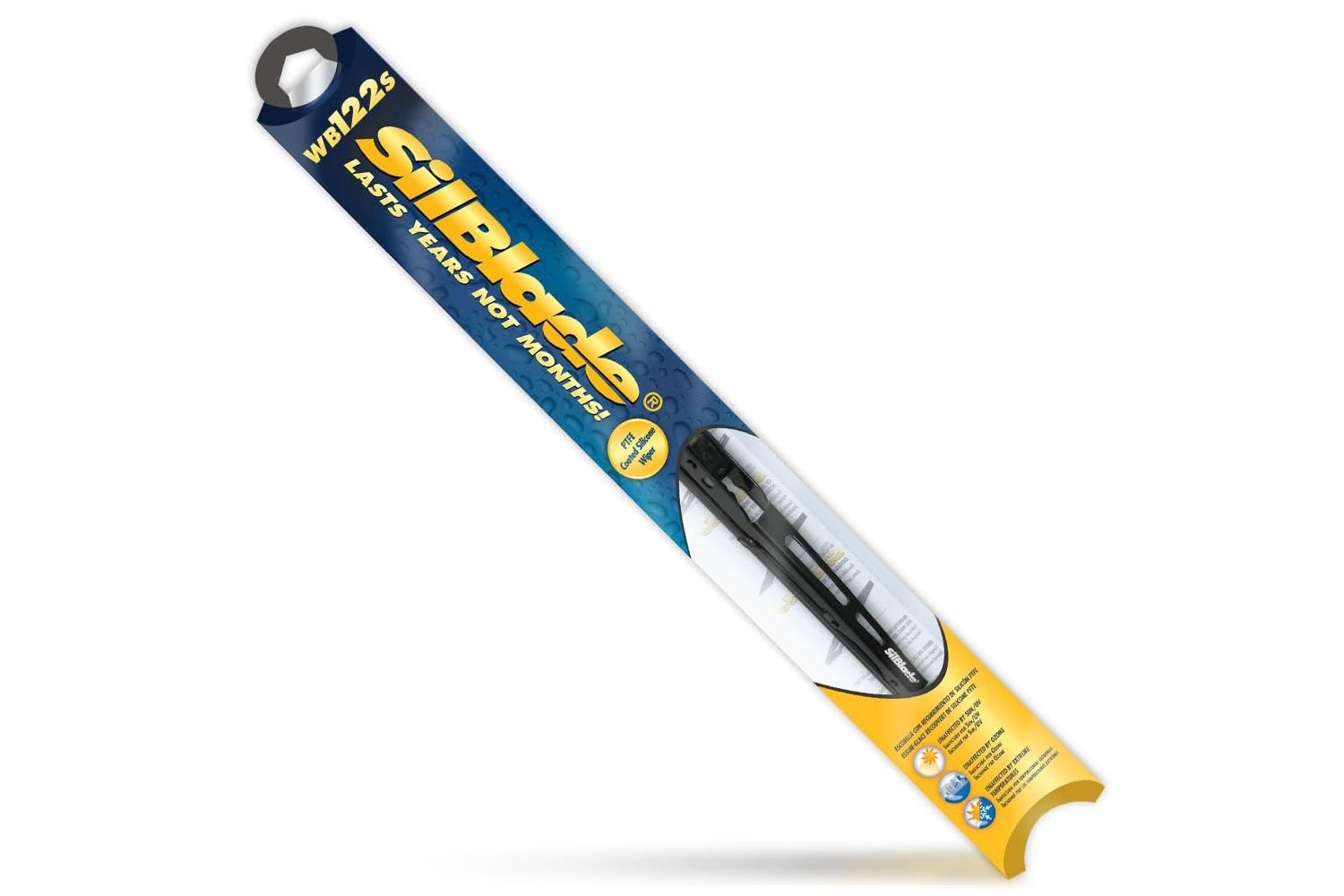 SilBlade Standard wiper blade, showcasing its traditional branch style and silicone blade, highlighting it as a best rated wiper blade for branch-style preference.
SilBlade Standard wiper blade, showcasing its traditional branch style and silicone blade, highlighting it as a best rated wiper blade for branch-style preference.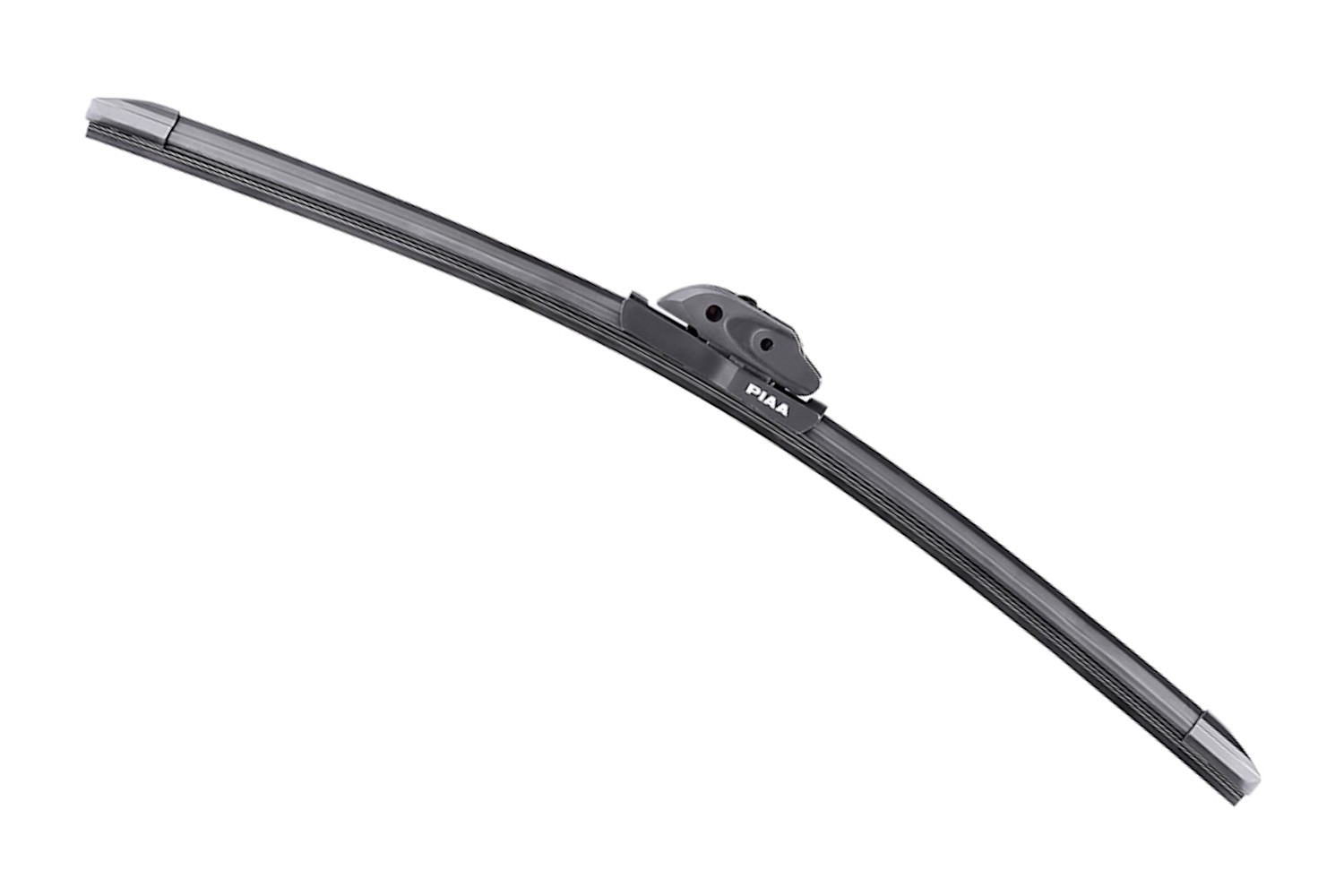 PIAA Si-Tech wiper blade, showcasing its premium beam design and silicone blade, highlighting its status as a best rated wiper blade for premium performance.
PIAA Si-Tech wiper blade, showcasing its premium beam design and silicone blade, highlighting its status as a best rated wiper blade for premium performance.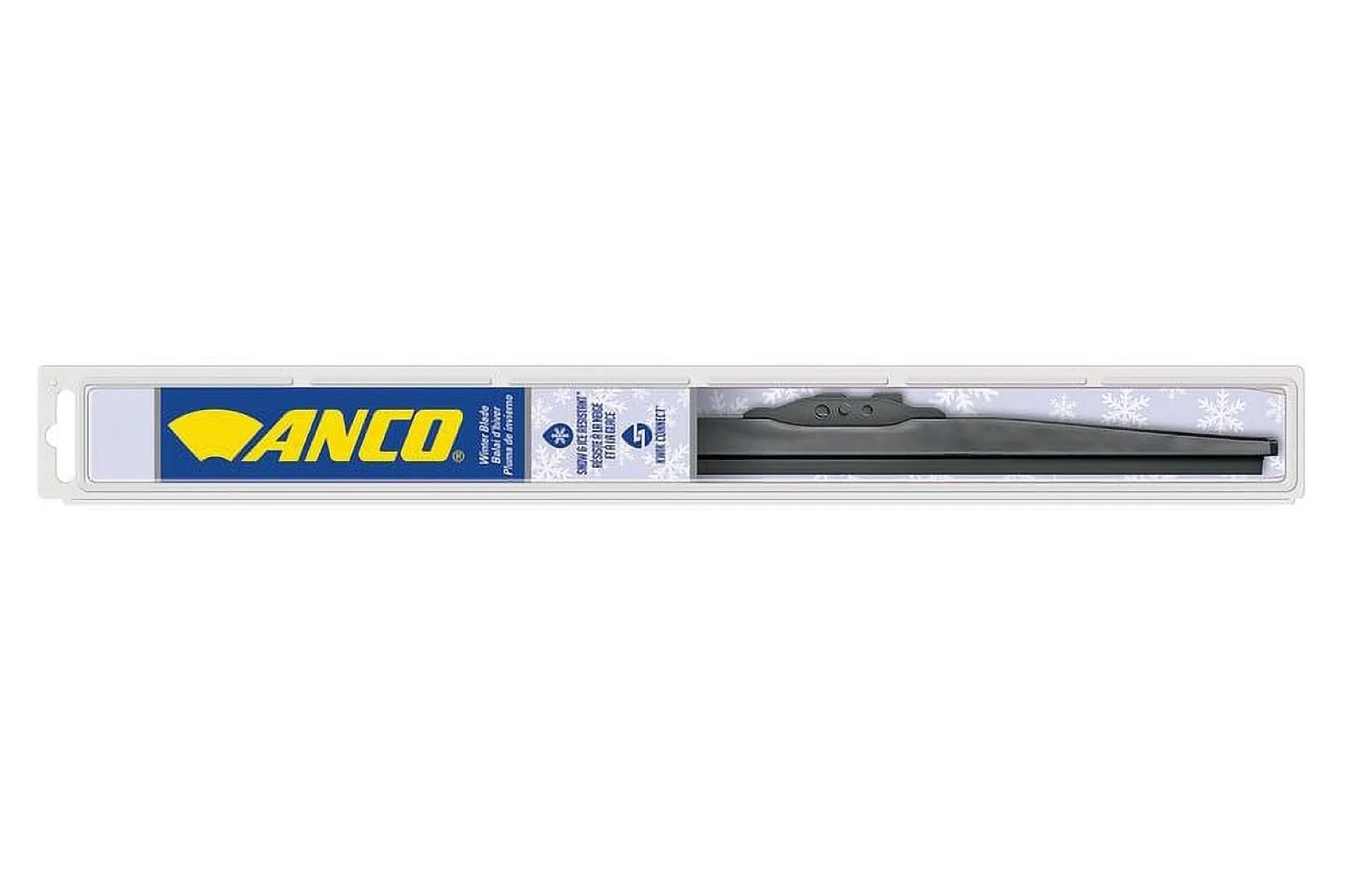 Anco Winter Wiper blade, featuring its branch style and rubber blade encased in a protective cover, emphasizing its role as a best rated wiper blade for winter conditions.
Anco Winter Wiper blade, featuring its branch style and rubber blade encased in a protective cover, emphasizing its role as a best rated wiper blade for winter conditions.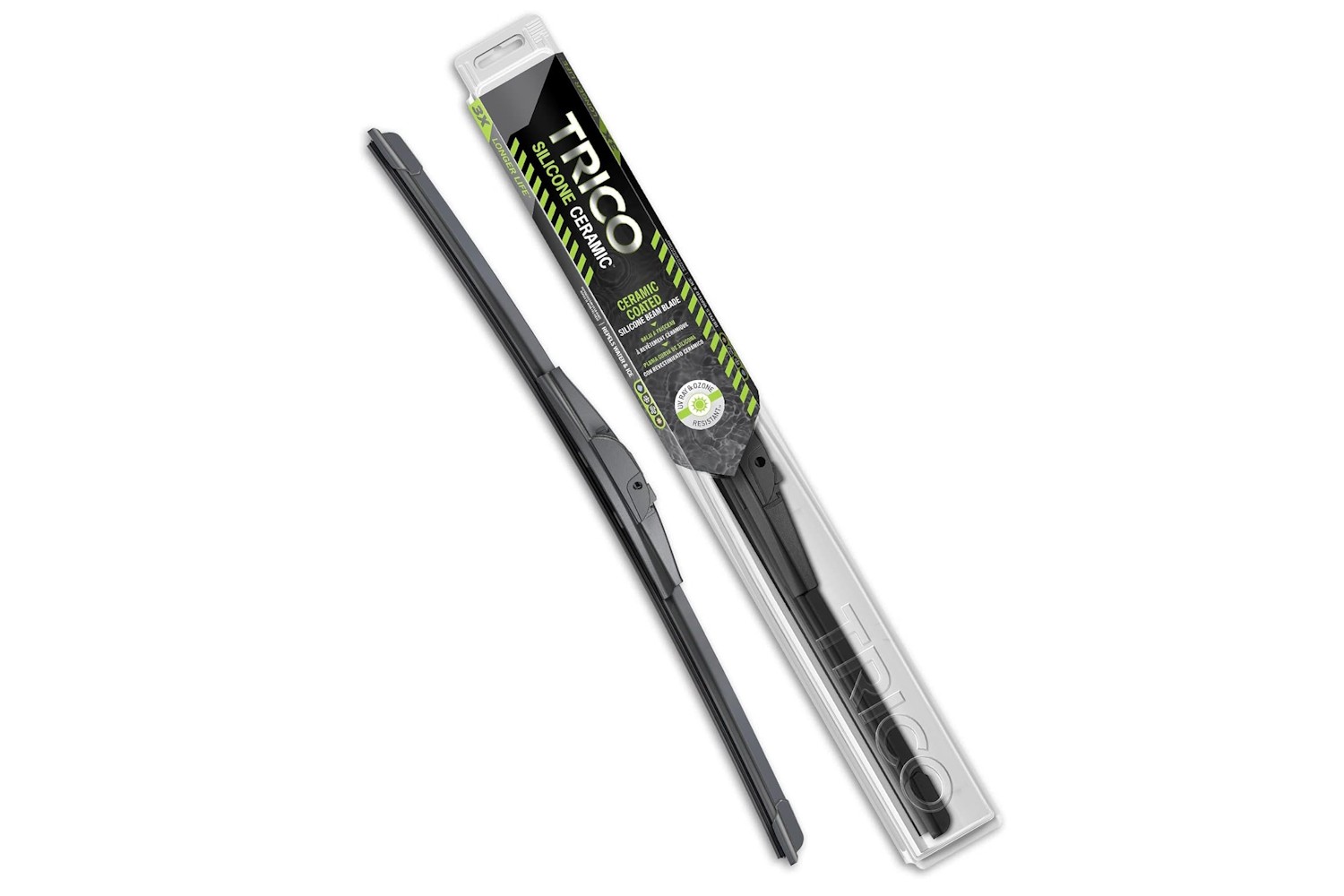 Trico Silicone Ceramic wiper blade, showcasing its aerodynamic beam design and silicone blade with ceramic coating, highlighting it as a highly rated alternative wiper blade option.
Trico Silicone Ceramic wiper blade, showcasing its aerodynamic beam design and silicone blade with ceramic coating, highlighting it as a highly rated alternative wiper blade option.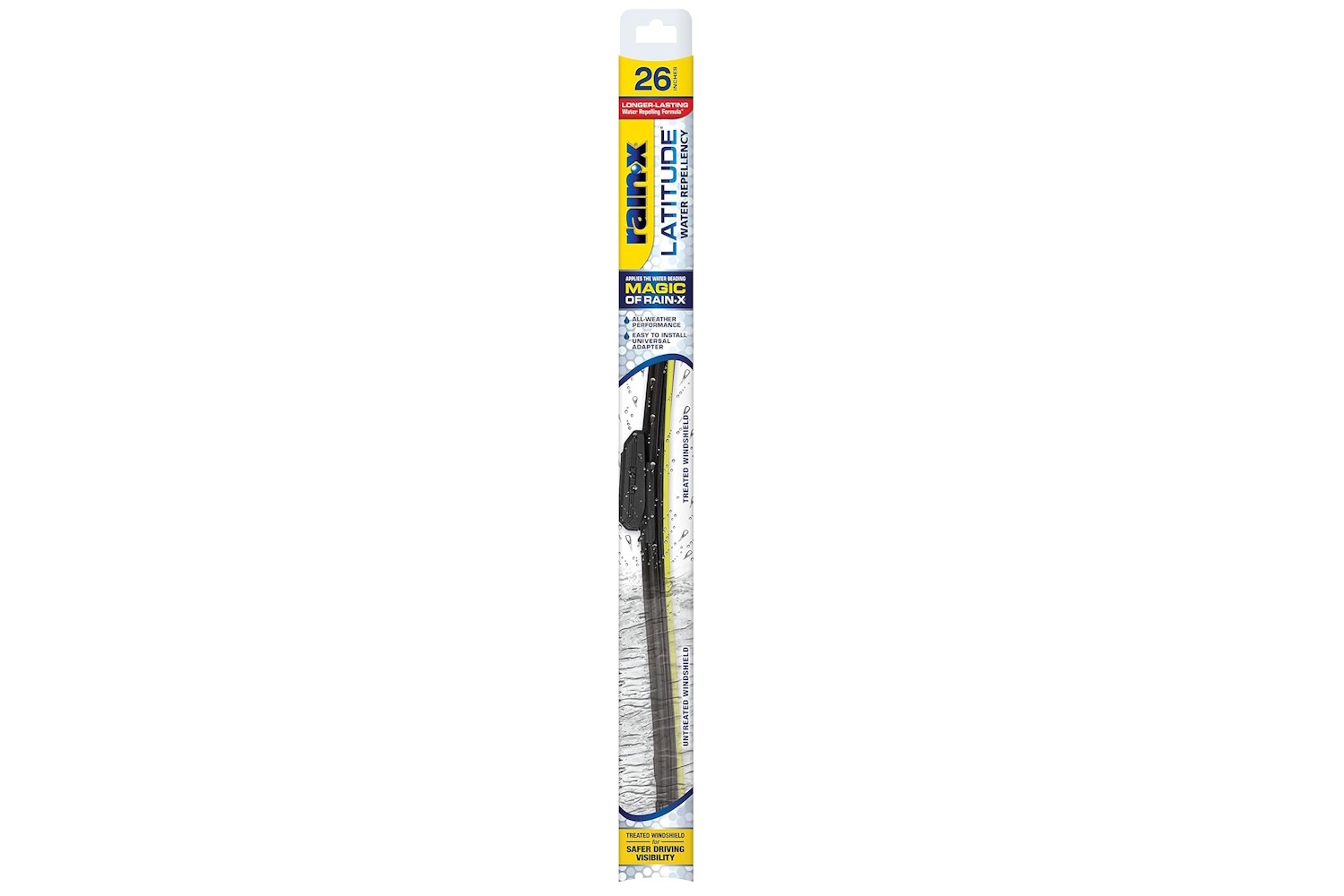 Rain-X Latitude Water Repellency wiper blade, showcasing its beam design and rubber blade with Rain-X coating, highlighting it as a well-rated mid-tier wiper blade.
Rain-X Latitude Water Repellency wiper blade, showcasing its beam design and rubber blade with Rain-X coating, highlighting it as a well-rated mid-tier wiper blade.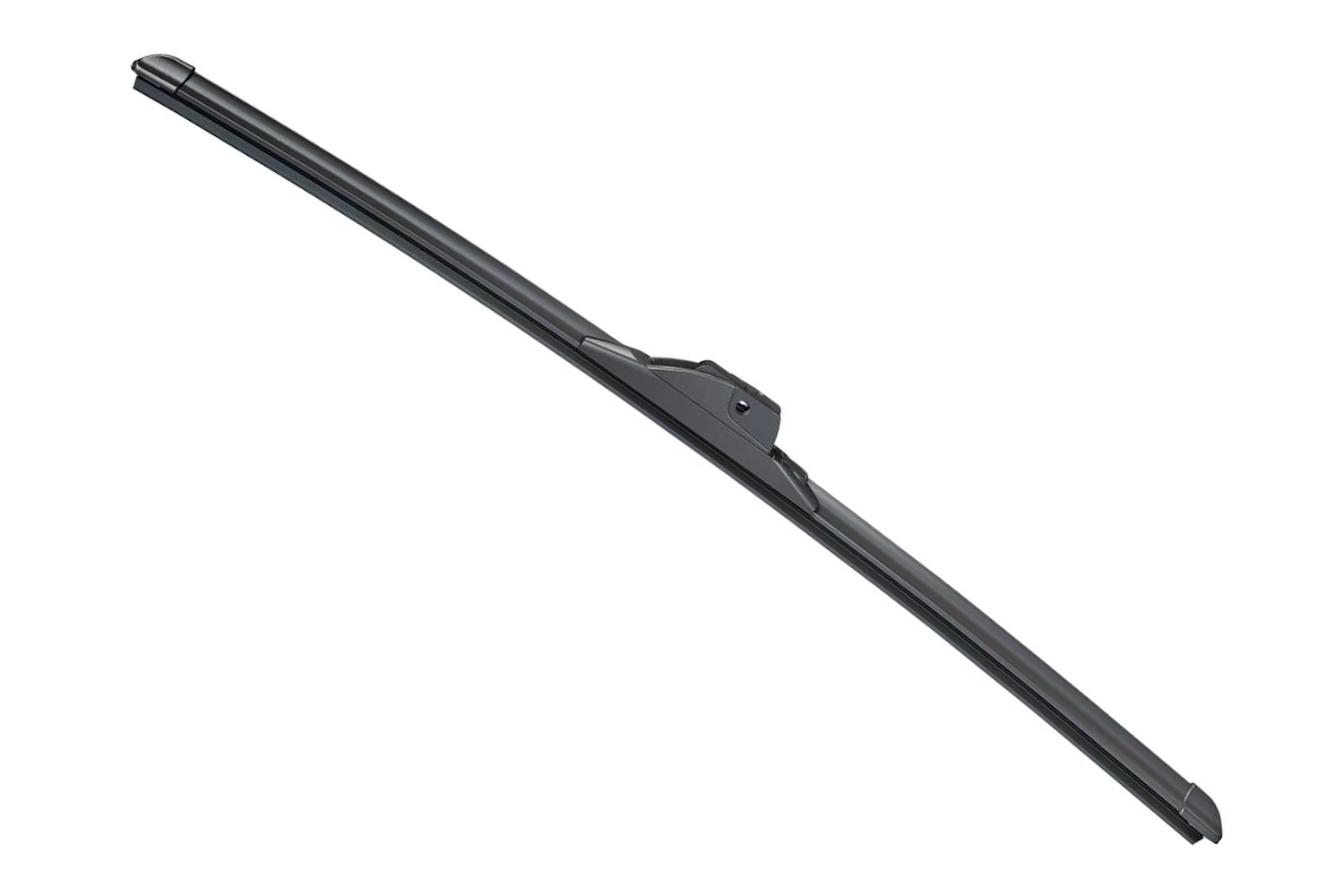 Trico Flex wiper blade, showcasing its beam design and rubber blade, highlighting it as a well-rated budget-friendly wiper blade.
Trico Flex wiper blade, showcasing its beam design and rubber blade, highlighting it as a well-rated budget-friendly wiper blade.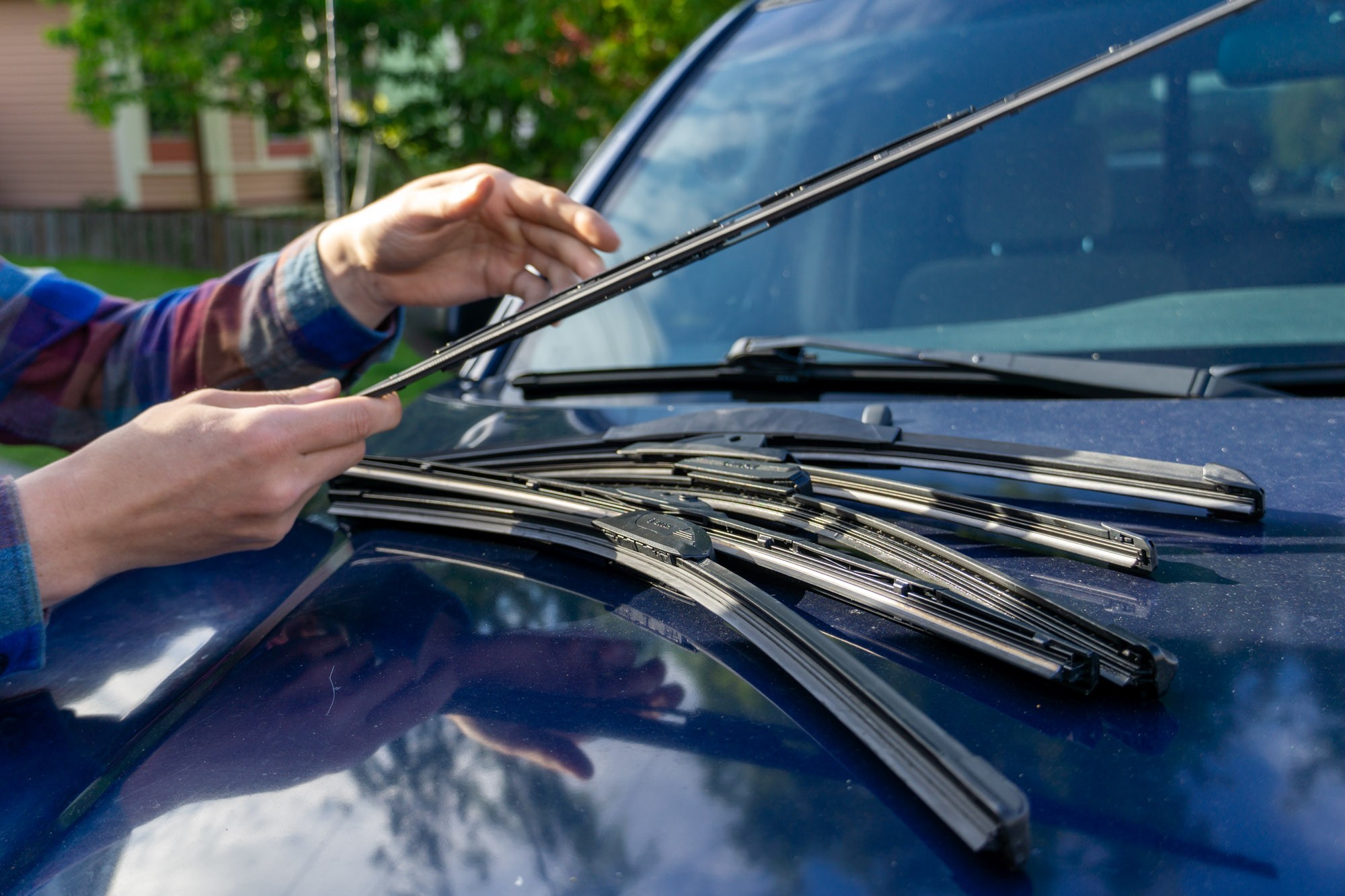 A selection of various wiper blades laid out on the hood of a truck, ready for installation and testing, visually representing the range of best rated wiper blades.
A selection of various wiper blades laid out on the hood of a truck, ready for installation and testing, visually representing the range of best rated wiper blades.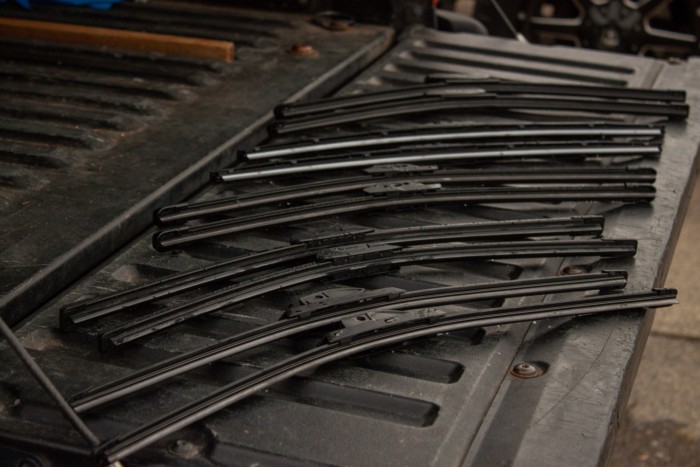 Five sets of wiper blades laid out on a truck tailgate, ready for comparative testing to determine the best rated wiper blades.
Five sets of wiper blades laid out on a truck tailgate, ready for comparative testing to determine the best rated wiper blades.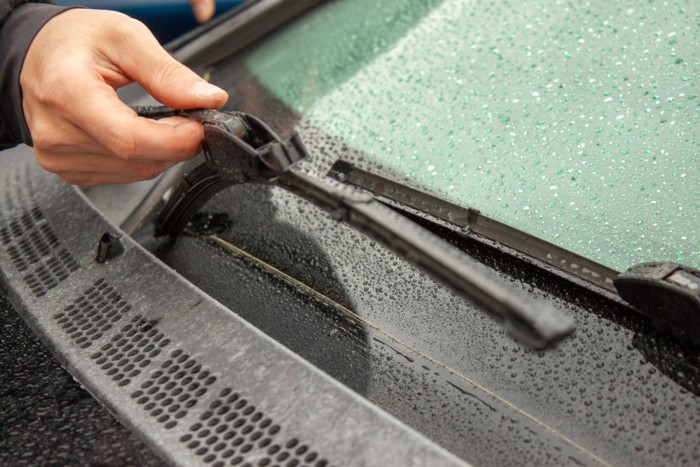 Hands lifting wiper blades from a wet windshield, emphasizing the importance of timely replacement for best rated wiper blade performance.
Hands lifting wiper blades from a wet windshield, emphasizing the importance of timely replacement for best rated wiper blade performance.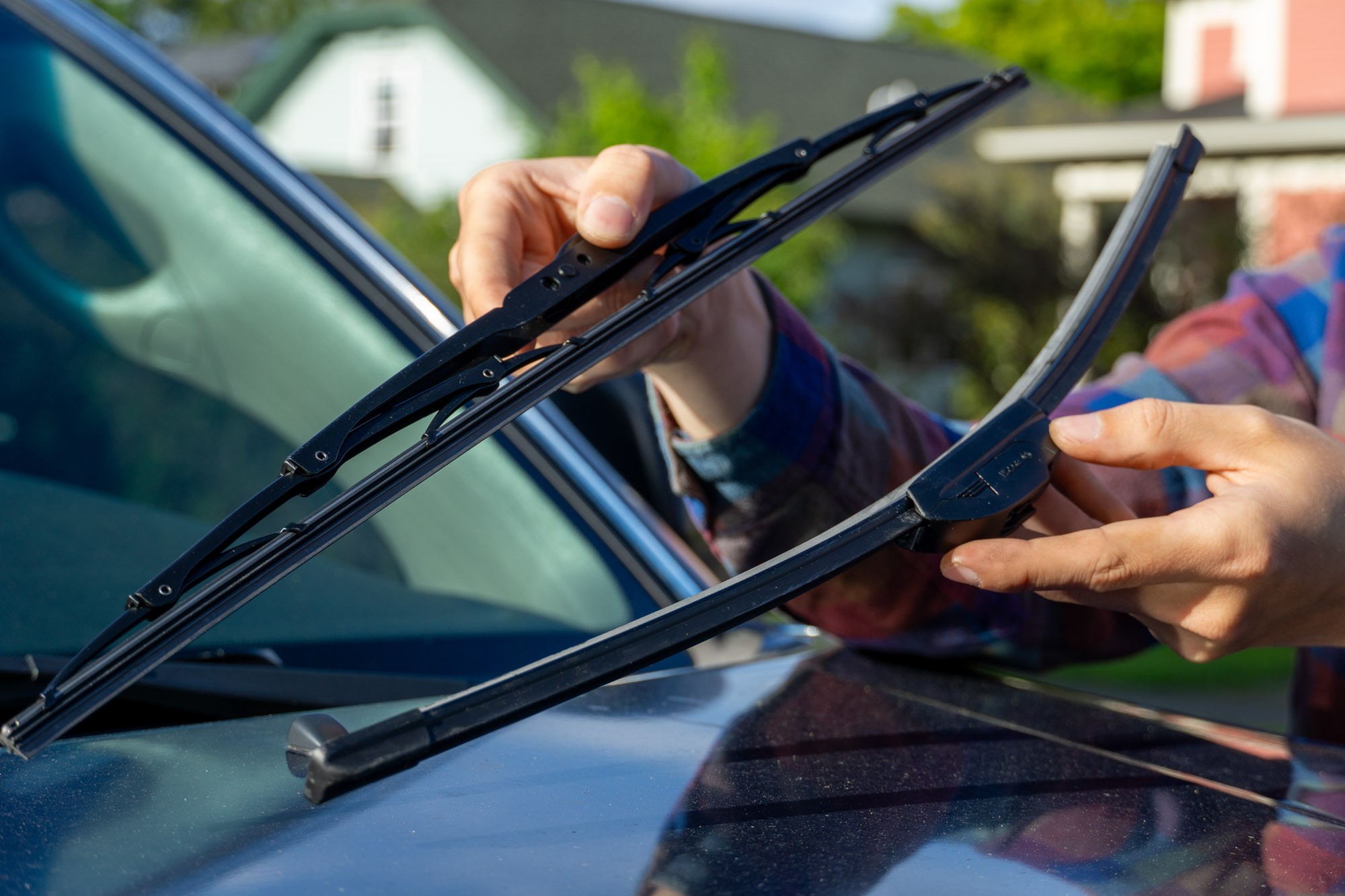 Displaying branch and beam style wiper blades side-by-side, illustrating the design differences between traditional and modern best rated wiper blades.
Displaying branch and beam style wiper blades side-by-side, illustrating the design differences between traditional and modern best rated wiper blades.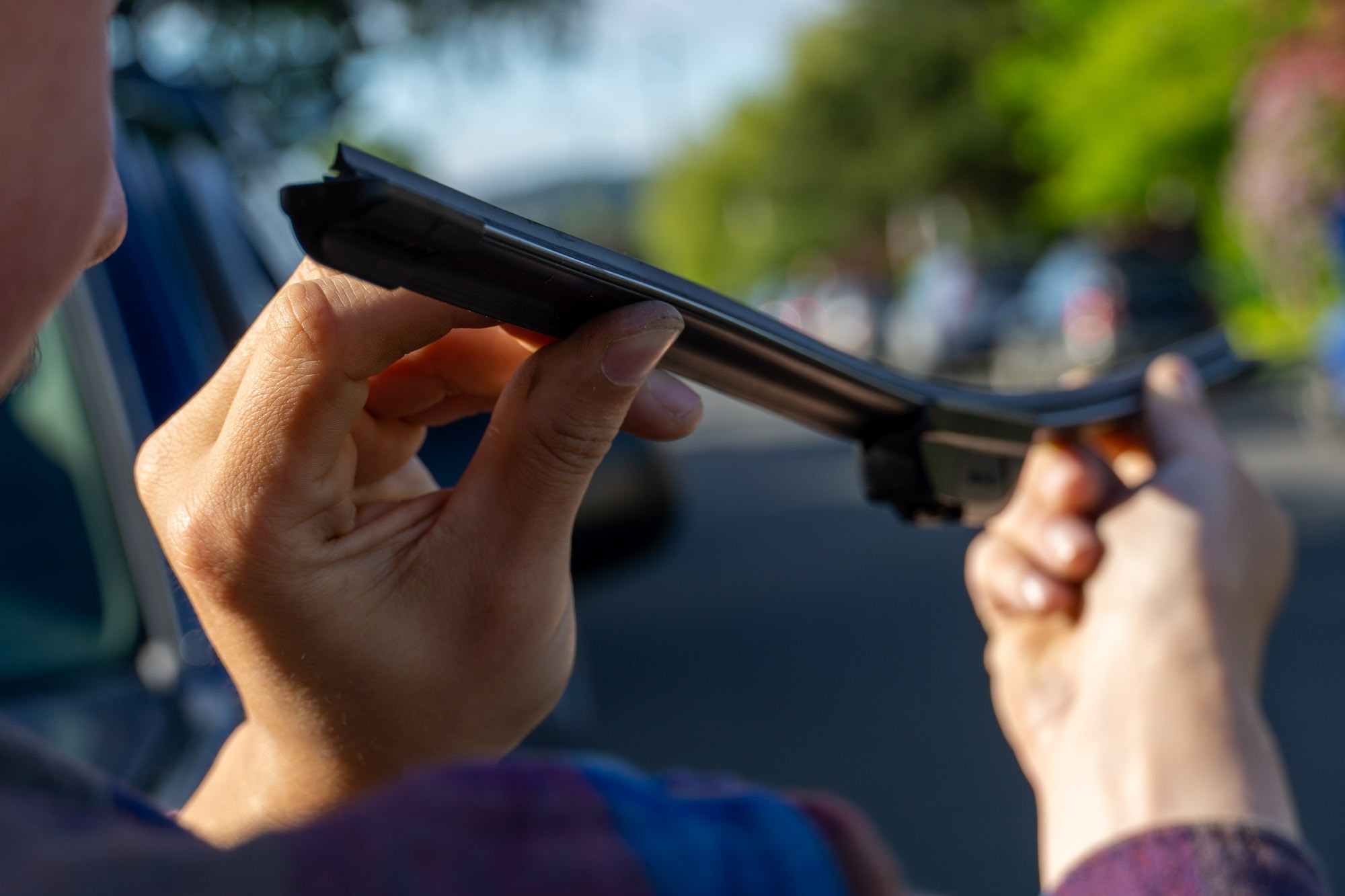 Close-up view of a beam wiper blade's curvature, demonstrating how beam style best rated wiper blades maintain consistent windshield contact.
Close-up view of a beam wiper blade's curvature, demonstrating how beam style best rated wiper blades maintain consistent windshield contact.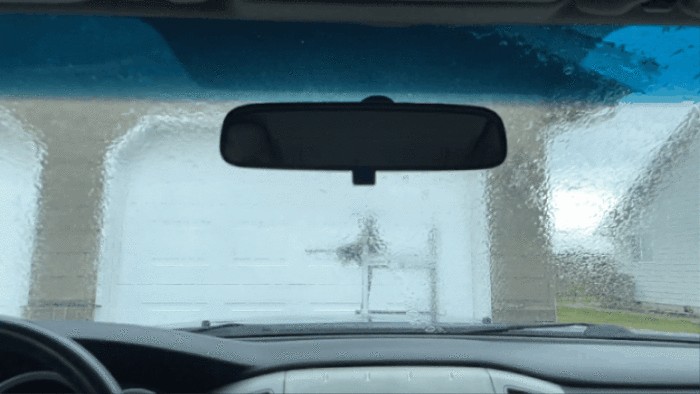 Animated GIF showing the interior view of a truck during a wiper blade test, demonstrating the water clearing performance of best rated wiper blades.
Animated GIF showing the interior view of a truck during a wiper blade test, demonstrating the water clearing performance of best rated wiper blades.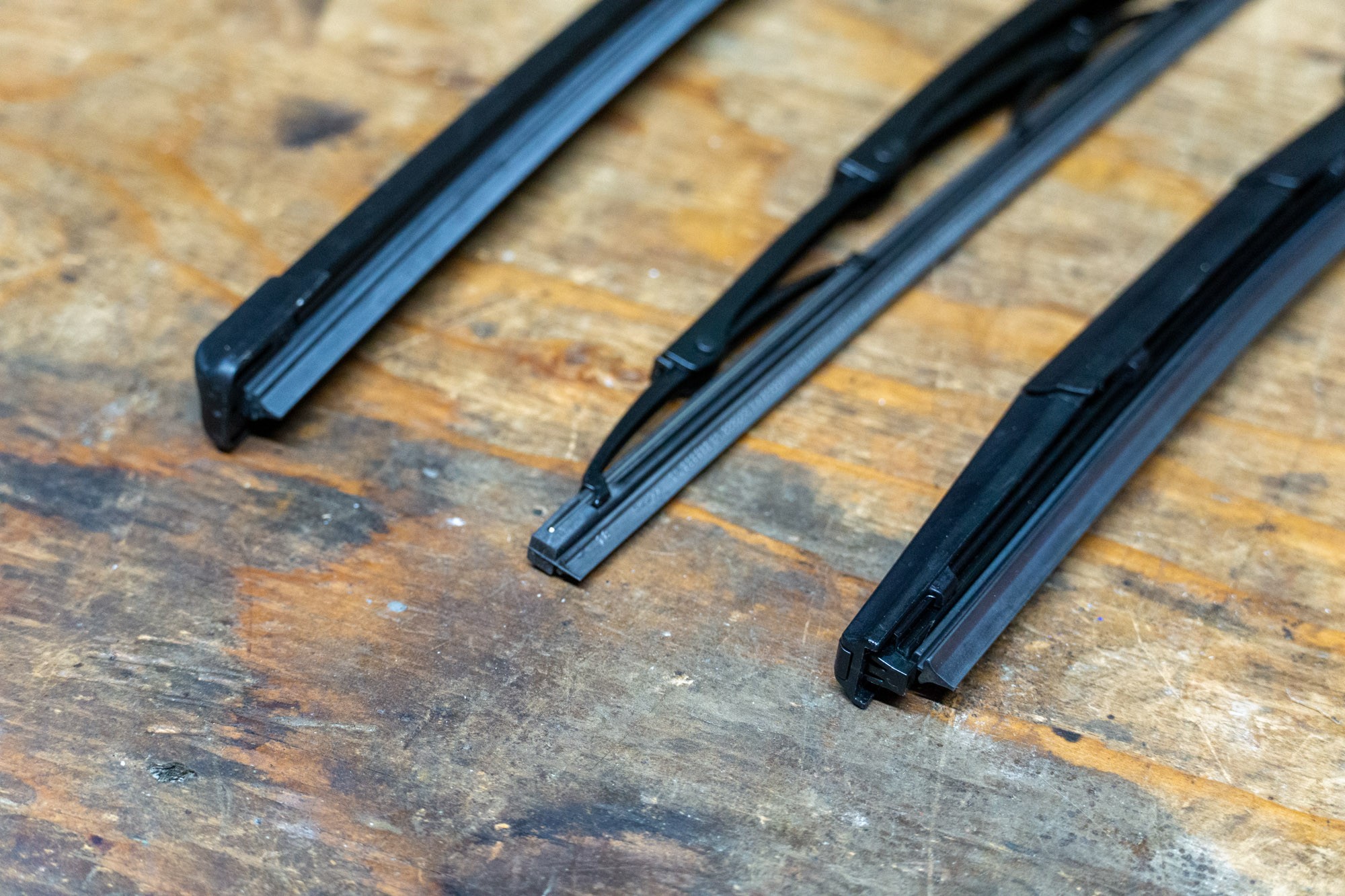 Three sets of wiper blades highlighting different blade material and design, showcasing the variety in best rated wiper blades materials.
Three sets of wiper blades highlighting different blade material and design, showcasing the variety in best rated wiper blades materials.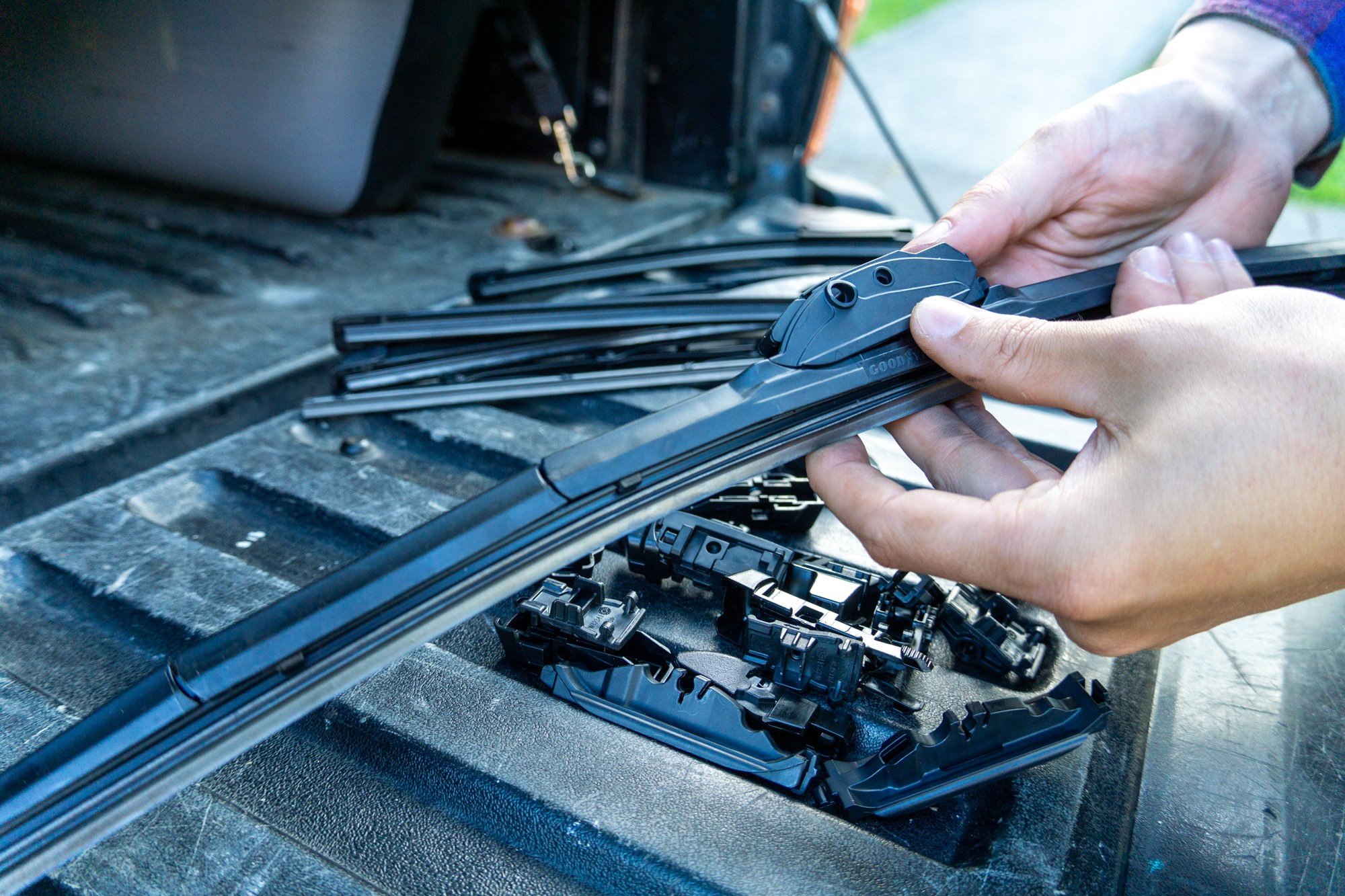 Close-up of wiper blade mounts being swapped out, highlighting the different attachment mechanisms for best rated wiper blades.
Close-up of wiper blade mounts being swapped out, highlighting the different attachment mechanisms for best rated wiper blades.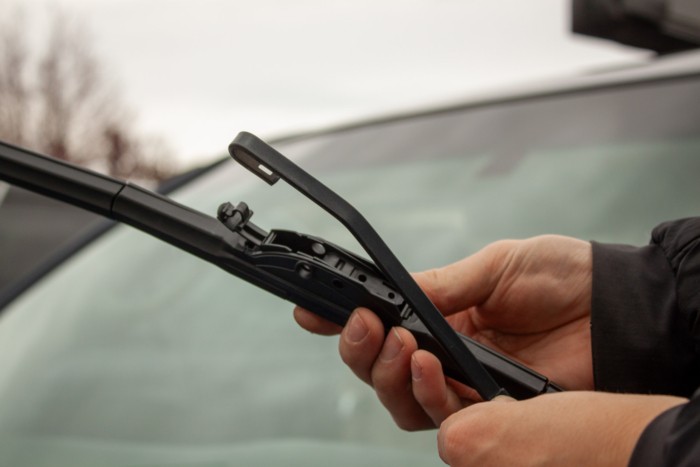 Hands attaching a wiper blade to a wiper arm, demonstrating the J-hook attachment, a common mounting type for best rated wiper blades.
Hands attaching a wiper blade to a wiper arm, demonstrating the J-hook attachment, a common mounting type for best rated wiper blades.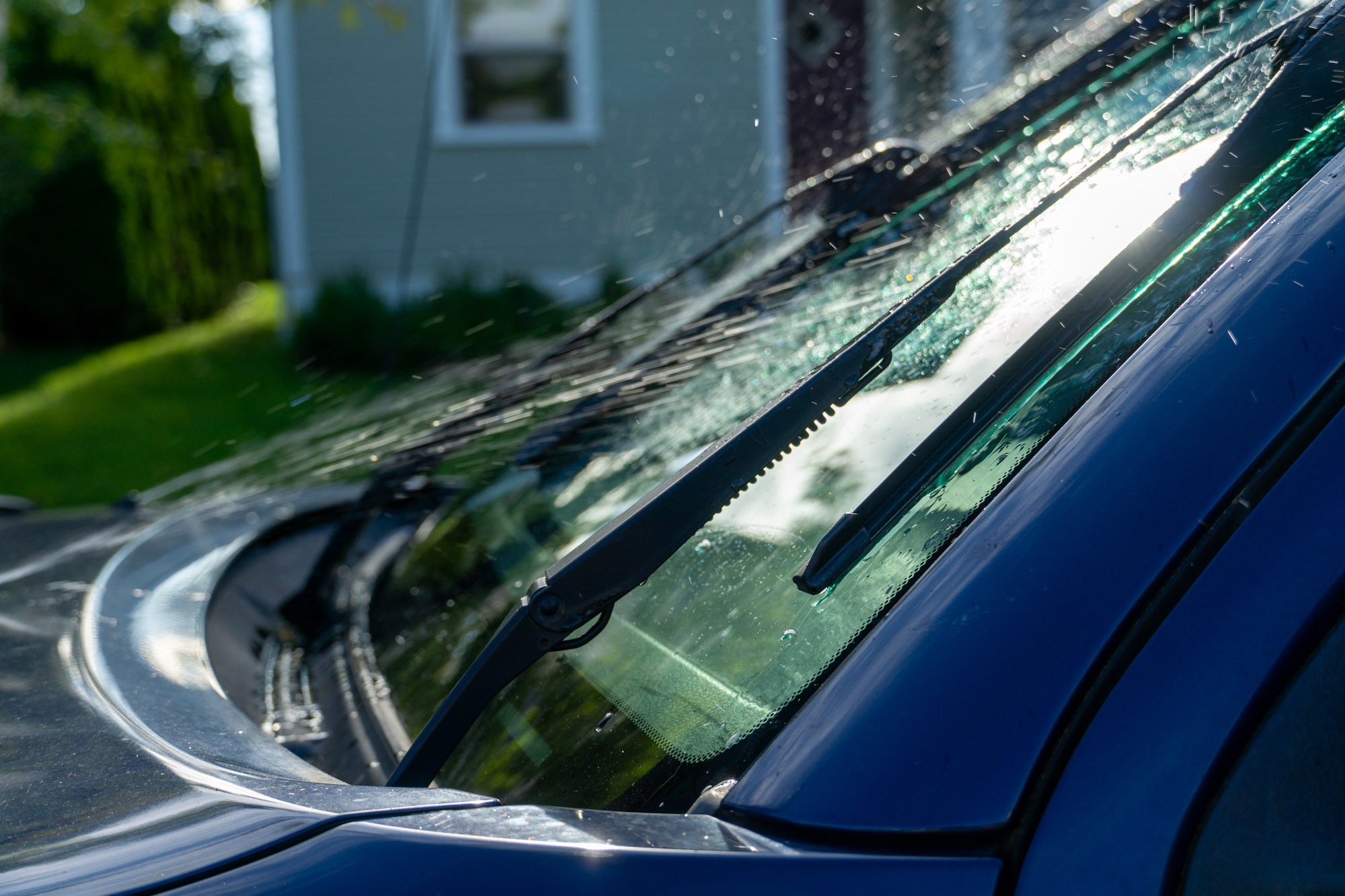 Wiper blades in operation with washer fluid spray, emphasizing the importance of replacing best rated wiper blades before visibility is compromised.
Wiper blades in operation with washer fluid spray, emphasizing the importance of replacing best rated wiper blades before visibility is compromised.